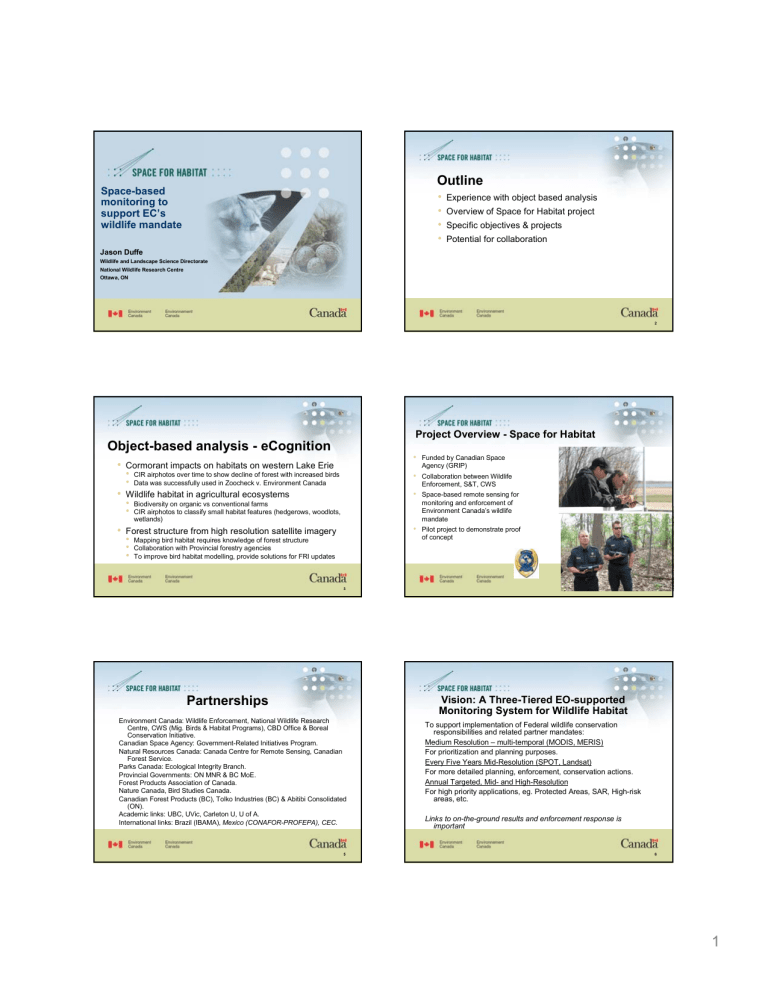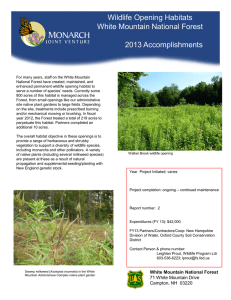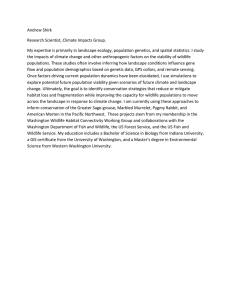Outline • Space-based monitoring to

Space-based monitoring to support EC’s wildlife mandate
Jason Duffe
Wildlife and Landscape Science Directorate
National Wildlife Research Centre
Ottawa, ON
Outline
• Experience with object based analysis
• Overview of Space for Habitat project
• Specific objectives & projects
• Potential for collaboration
Object-based analysis - eCognition
• Cormorant impacts on habitats on western Lake Erie
•
CIR airphotos over time to show decline of forest with increased birds
•
Data was successfully used in Zoocheck v. Environment Canada
• Wildlife habitat in agricultural ecosystems
•
Biodiversity on organic vs conventional farms
•
CIR airphotos to classify small habitat features (hedgerows, woodlots, wetlands)
• Forest structure from high resolution satellite imagery
•
Mapping bird habitat requires knowledge of forest structure
•
Collaboration with Provincial forestry agencies
•
To improve bird habitat modelling, provide solutions for FRI updates
3
Project Overview - Space for Habitat
•
Funded by Canadian Space
Agency (GRIP)
•
Collaboration between Wildlife
Enforcement, S&T, CWS
•
Space-based remote sensing for monitoring and enforcement of
Environment Canada’s wildlife mandate
• Pilot project to demonstrate proof of concept
4
Partnerships
Environment Canada: Wildlife Enforcement, National Wildlife Research
Centre, CWS (Mig. Birds & Habitat Programs), CBD Office & Boreal
Conservation Initiative.
Canadian Space Agency: Government-Related Initiatives Program.
Natural Resources Canada: Canada Centre for Remote Sensing, Canadian
Forest Service.
Parks Canada: Ecological Integrity Branch.
Provincial Governments: ON MNR & BC MoE.
Forest Products Association of Canada.
Nature Canada, Bird Studies Canada.
Canadian Forest Products (BC), Tolko Industries (BC) & Abitibi Consolidated
(ON).
Academic links: UBC, UVic, Carleton U, U of A.
International links: Brazil (IBAMA), Mexico (CONAFOR-PROFEPA), CEC.
5
Vision: A Three-Tiered EO-supported
Monitoring System for Wildlife Habitat
To support implementation of Federal wildlife conservation responsibilities and related partner mandates:
Medium Resolution – multi-temporal (MODIS, MERIS)
For prioritization and planning purposes.
Every Five Years Mid-Resolution (SPOT, Landsat)
For more detailed planning, enforcement, conservation actions.
Annual Targeted, Mid- and High-Resolution
For high priority applications, eg. Protected Areas, SAR, High-risk areas, etc.
Links to on-the-ground results and enforcement response is important
6
2
1
IBAMA - Brazil
Image acquisition
& analysis
Communication –
Deforestation maps
Enforcement Response
7
Federal Wildlife Mandate -
Legislative Context
• 3 Acts to protect habitat for
Canadian species:
• Canada Wildlife Act
•
Protected Areas – National Wildlife
Areas (NWA)
• Migratory Birds Convention
Act (MBCA)
•
Incidental Take of nests/individuals during industrial activities
•
Protected Areas - Migratory Bird
Sanctuaries (MBS)
• Species at Risk Act (SARA)
•
Effective protection of Critical
Habitat
8
Protected Areas
• Develop national landcover monitoring plan
•
Spatial and temporal resolution informed by pilot study
•
Including data acquisition and analysis protocols
• Build effective capacity to use geospatial technologies
•
Train and equip field officers to use products
•
Build database of ground/field observations
•
Investigate applicability of technologies to other enforcement activities
• Budget 2008 - $1.1 million (2 years) for geomatics support of enforcement in Protected Areas
9
National Wildlife
Areas
Migratory Bird
Sanctuaries
Space for Habitat
Pilot Sites
10
•
~65 officers, ~12 million ha., in addition to CITES, hunting patrols, etc
•
Average distance of nearest officer: ATL: 300km (15-700) QC: 800km
(0-1700) ON: 400km (150-1200) PNR: 450km (5-2000) PYR: 350 (0-
1000)
•
Officer visits each PA once every 10 years on average
•
Little enforcement presence in NWA’s (Auditor General 2008)
Many large, northern Protected Areas
• officer patrols are impractical and expensive
• development activities are increasing
• satellite monitoring will be most effective
11
Boundary Incursions
IKONOS 1m NCC
• Cranberry farming in region encroaching the
NWA boundary, highway development, logging all change land cover composition and structure
1
Portobello Creek Time 1 (1989) Portobello Creek Time 2 (2001)
12
2
Geomatics for Wildlife Enforcement Seminar
• Developed 3 day GWE seminar in cooperation with Smithsonian
Institute - National Zoological
Park
• Intro to GIS, GPS and Remote
Sensing – ESRI ArcPad
•
Hosted at Carleton University
GIS computer labs
•
Delivered course May 2007 – refresher course in May 2008.
13
Protected Areas – sub-projects
• EO acquisition plan – optical/radar (NWRC)
• Technology transfer – field data collection (NWRC)
• Implement enterprise geospatial data mngt (NWRC)
• Radarsat-2 quad-pol for change detection (Carleton)
• Wetland mapping/classification (M. Grenier, CCRS)
• Biodiversity monitoring of wetlands – RAMSAR (UBC, CFS)
14
Migratory Birds Convention Act
Incidental Take
• Provinces have mandate for natural resources & land management
(forestry, mineral extraction, development etc)
•
Each jurisdiction has different guidelines, regulations, planning requirements
•
Focus on riparian integrity, provincial species, general wildlife habitat provisions
•
Environment Canada developing new regulations under MBCA to mitigate & manage incidental take from industrial activities
• S4H evaluating use of space-based monitoring for planning, monitoring and enforcement of new regulations
•
Focus on BCR plans, priority & focal species
•
Working with forestry industry to begin – companies in Ontario & British Columbia
15
Advantages of Earth Observation based national system
• Easily updated – new imagery
• Not limited by jurisdiction or ownership
• Potential to incorporate cumulative impacts (fire, development, insects, oil and gas etc.)
• Incorporate natural and anthropogenic changes
• Same data can be used for both habitat models and compliance monitoring
16
RIPARIAN GUILD
REMOTE-SENSING DATA
Topography
Solar radiation
Distance to herbaceous
INPUTS
MAXENT
Legend
OSFL
0
1-10
11-20
21-30
31-40
41-50
51-60
61-70
71-80
81-90
91-100
Forest fragmentation
Mid IR
Distance to water
FRI AND HARVEST DATA
FOREST
MANAGEMENT
10
Kilometers
MODEL SELECTION (AIC)
RECOMMENDATIONS
More snags 70 m buffers
MBCA – sub-projects
• Priority species modelling at BCR level with EO (NWRC)
• Develop suite of attributes in Bird Conservation Plans to monitor using
EO data
•
IT Regulatory implementation using EO data – bird conservation plans
(NWRC)
• Develop medium resolution protocols for national monitoring
(landcover, change, etc) (CCRS, CFS)
• Radarsat-2 (quad-pol) for wetland mapping/classification (CCRS, CWS)
• Airborne LIDAR and Hyperspectral for improved habitat models (UVIC,
UBC)
•
Modelling waterbird occurrence using EO data – focus on rare birds – model based sampling (CWS, UOttawa)
18
3
Species at Risk Act - Critical Habitat
Boreal Caribou
• Ecological niche modelling for predicting woodland caribou habitat – 1km MODIS
•
Model based sampling to improve surveys, population estimates
•
Identify habitat for potential rehabilitation
• Next steps – effective protection, monitoring compliance
• S4H – develop monitoring protocols to maintain integrity of protected Critical Habitat
•
Large areas that may be difficult to monitor on the ground
•
Evaluate management implications for biodiversity
19
4
0 250 500
Kilometers
1,000
SARA – sub-projects
• Ecological niche modelling (ENM) for model based sampling (OMNR, CFS)
• ENM vs. RSF – sources of bias, model errors (U Montana)
• Develop change detection protocols to monitor compliance with Critical Habitat (NWRC)
International Projects
Canada-Mexico partnership – Wildlife Enforcement capacity building
• Jaguar conservation in southern Mexico – habitat modelling/mapping/monitoring
• Monarch Flyway Protection
• Technology transfer – provide GWE for Mexican Wildlife
Officers
22 21
Summary
• Landcover, Landuse, structure – refinements for improved habitat modelling
• Change detection – natural vs anthropogenic
• Focus on operational use – limitations, standardization, repeatability jason.duffe@ec.gc.ca
– www.spaceforhabitat.ca
23 24
Legend
Boreal population
Biotic models
Average Probability
0 - 10
10.00000001 - 20
20.00000001 - 30
30.00000001 - 40
40.00000001 - 50
50.00000001 - 60
60.00000001 - 70
70.00000001 - 80
80.00000001 - 90
90.00000001 - 100
20
4







